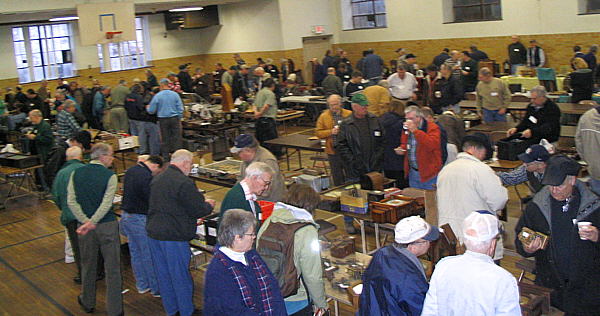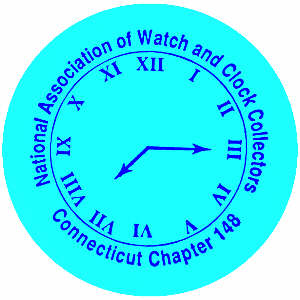
|
Jim Katzin, Pres.
Cheryl A. Comen, Sec./Tres.
409A Montauk Lane
Stratford, CT 06614
|
Meetings Past
November 15, 2008 Meeting Highlights
by Rich Huck
November Meeting - Chapter 148 held its last meeting of the year at the Newtown Town Hall with a good turnout of members and quests. As usual the tables were filled early and mart activity was brisk as were the discussions around the coffee and donut tables.
Attendees could not help but notice the 12 massive baskets scheduled for raffle later in the morning. This holiday tradition of the Chapter is accomplished through the generous and annual donation of time by Cheryl and Al Comen, two of the Chapter's mainstay volunteers. The 12 winners were treated to an array of fruit, chocolate, and a fine bottle of wine. Thanks, Cheryl and Al.
November Program: Regular Chapter business activity precluded any formal presentation this day, but Dr. David Follett, long-time and well-known Chapter member, kindly brought along a prize piece of history from his collection to share with the membership. His well documented gem was a 16th century clock with automation built by the Augsburg, Germany clockmaker, Johannes Ott Hanschlager (J.O.H.). According to Dave's descriptive placard, Hanschlager was a Purveyor to the Hoenzollern Court and was active during the period 1585-1610. This particular clock was purportedly made for the Archduke sometime between 1590 and 1605.
Dave acquired this clock some years ago. It had been in the collection of Justice Sheproe who bought and restored all the parts. Late in the 17th century, the clock experienced a conversion to a crown wheel and rear "cow's tail pendulum". Only six examples are known to exist with the original balance wheel mechanism. All the trains are in working order, however, Dave removed the links to the all important automation to facilitate his transporting of the clock. The clock runs for 30 hours on a single fusee for time with additional barrels for the automation.
Augsburg was one of the most important cities of Renaissance Germany with a population of some 40,000 by 1618. It, along with Nuremberg, was a key metalworking town where clockmaking flourished during the 15th and 16th centuries. Between 1550-1650 some 182 master clockmakers were listed in the guilds operating in some 50-75 shops.
The clocksmiths of Augsburg, in the 1500's, were among the most sophisticated horologists in the world. Admittance to the guild as a master clockmaker required the creation and submission of a complex and high quality piece. The guild wrote down in great detail what a then "state-of-the-art" clock in the 1530's looked like; they described what today would be called a striking, four-sided, renaissance tabernacle clock with astronomical indications. This definition of the required masterpiece was updated once (in 1577) but stayed in force until the 1730's.
These "masterpieces" were prized by the wealthy (like the Archduke above) who would often display the piece at the center of a dinner table with the complex automation striking at an appropriate time to impress their quests.
We thank David for sharing this highly unique clock with us.
* * *
September 20, 2008 Meeting Highlights
by Rich Huck
The cool autumn feel to the morning air seemed to pervade the meeting hall Mart as over 100 members and friends of Chapter 148 engaged in some crisp and lively discussions concerning the buying and selling of table items and just some good friendly exchange of information. This meeting also signaled the initiation of the current writer as reporter of the Chapter Meeting Highlights and Program. However, more importantly, it has sadly ended that responsibility for Mary Jane Dapkus. Mary Jane is certainly well known to members for her past coverage of Chapter meetings as well as for her many quality submissions to the Research Committee of the NAWCC. Please join with me in thanking Mary Jane for her many years of reporting for the Chapter (almost 10) and encourage her to keep up the research. She has established a quality standard (and longevity) which will be difficult to match.
Following the meeting in the basement room of the Newtown Town Hall, it was only appropriate that members made their way to the top floor of this beautiful building in order to view a presentation by John Rives which yielded a series of clock photos which were both top of line and beautiful. John set the tone early by showing a John Goddard (1723-85)-cased, tall clock which once had been appraised by Christies at $1.1 million. This Caleb Wheaton (1757-1827) clock was the most valuable one on which John had ever worked.
John Rives, a clock restorer and repairman based in Worchester, MA, began his business venture in 2000 following completion of the course program at the School of Horology in Columbia, PA. As a native of Newport, RI, John has been extremely fortunate to have had the opportunity to work on some of the finest and most valuable clocks in Newport, inlcuding many of those housed in the Newport Mansions, like the "Breakers".
John carefully walked us through the stories and his experience in repairing many of these Newport gems such as the early 19th century James McCabe carriage clock which once had been hidden in the ashes of a fireplace in order to avoid the tax assessors' inventory. Unfortunately (for the owners), the clock struck the hour at the very moment assessors were in the house. We viewed a burl-wood, tall case clock housed in the Newport Tennis Club which has, most appropriately, tennis players featured on the dial with "rackets" that move on the given order. We also viewed: a series of carriage clocks housed in the Breakers and Chateau-su-Mer mansions; a tall clock in the Breakers which plays 12 songs on a 16 bell movement; a Dutch tall clock which played "only" two songs on 14 bells; and a 17th century John Taylor, London, bracket clock with finely engraved plates.
American clocks were not absent from the Newport presentation with examples of banjos by both Simon and Aaron Willard and an E. Howard tall clock. John showed us a J.J. Elliott tall case clock with nine tubes and brass weights totalling 43 lbs., a record for him. A circa 1605 John Hall, London, lantern clock was followed by the sole Newport representative - a William Claggett (1696-1749) tall case clock.
John clearly has a unique relationship with the Preservation Society of Newport County and their storied clocks. We have been rewarded with his sharing of that knowledge and experience. We thank him heartedly for it.
* * *
July 19, 2008 Meeting Highlights
by Mary Jane Dapkus
Chapter 148's well attended summer meeting took place on July 19th , a steamy Saturday morning. Members exchanged news over refreshments, and, of course, happily browsed the mart tables.
An area of collecting that is beginning to attract attention, centers around the World War II era, with the mart providing some fine opportunities to explore. Unusual items dating to the 1940s spotted that day included several shares of Waltham Watch Company common stock; an inexpensive Winsted, CT "War Alarm" timepiece with a U.S. government price control stamp, a miniature 8-d Waterbury carriage clock with both alarm and original case; and a "hyper-accurate" Chelsea radio room ship's clock. The latter tells time in two different time zones; red areas on the dial marked periods during which broadcasting was curtailed in favor of incoming emergency communications.
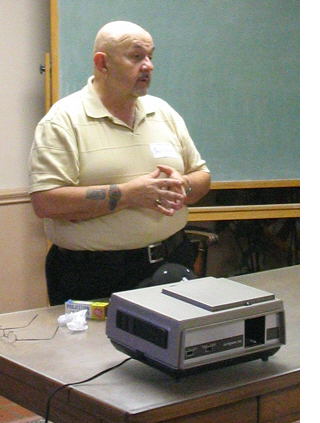 July's guest speaker was Chris Bailey, noted author and long-time horologist-in-residence at the American Clock & Watch Museum, Bristol, CT. The subject of Chris's talk was American weight driven banjo clocks. July's guest speaker was Chris Bailey, noted author and long-time horologist-in-residence at the American Clock & Watch Museum, Bristol, CT. The subject of Chris's talk was American weight driven banjo clocks.
A unique and utilitarian American design, the banjo evolved following Simon Willard's patent design of 1801. The origin of the term "banjo" applied to this style of clock is uncertain. However, Chris has documented its widespread use as early as 1904.
To the audience's delight, Chris illustrated his talk by means of superb photographs of rare examples of banjo clocks. He explained that the earliest banjo cases exhibited cross banding, bracketless bottoms, and pendulums suspended in t-shaped brackets. Movements were simply screwed into backboards.
Chris continued, providing the audience a chronological overview of styles and some makers that followed members of the Willard family. These included Jabez Baldwin, Levi Hutchins, Joshua Wilder of Hingham, Massachusetts, Curtis & Dunning of Vermont, Martin Cheney of Canada and Vermont, E. Howard & Co., Foster Campos, Elmer Stennes, the Sessions and Ingraham firms, Chelsea, and Herschede, up to the present day.
Many antique banjo clocks have been altered. Chris offered listeners some suggestions for avoiding potential pitfalls in collecting these alluring objects. Moreover, through his words listeners glimpsed the world of famous collections, legendary aquisitions, and both the lighter and darker sides of antiques shenanigans and fakery. Thus Chis provided much practical wisdom--which the audience very gratefully received.
Special congratulations is due to member Lawrence Byrne who recently received his NAWCC "old timer" pin. Lawrence, a historical researcher and self taught repairer of fine antique clocks, also has the enviable distinction of having once sat in Simon Willard's chair. And thanks is due to Ed Berns for his assistance in providing material for this writeup.
* * *
May 17, 2008 Meeting Highlights
by Mary Jane Dapkus
Chapter 148 members and friends gathered in the sparkling early morning hours of Saturday, May 17. Our mart tableholders exert a truly exceptional level of effort: their offerings that day amazed and delighted even the most discerning collectors among our numbers.
The Chapter recently hosted a series of suitcase workshops on the proper use of lathes in watch and clock repair. Even seasoned repairers who attended the workshops commented on the abundance of useful information gained, and on the workshops' effectiveness. Thanks to all who helped translate this great opportunity into reality!
Members enthusiastically welcomed the meeting's guest speaker, Richard W. Husher of Newton, Massachusetts, who spoke on the subject of Simon Willard clocks. Together with Walter W. Welch, Richard co-authored the book entitled A Study of Simon Willard's Clocks (Nahant, MA: Husher and Welch, 1980)--the book has become the most noted source of information on Willard's work.
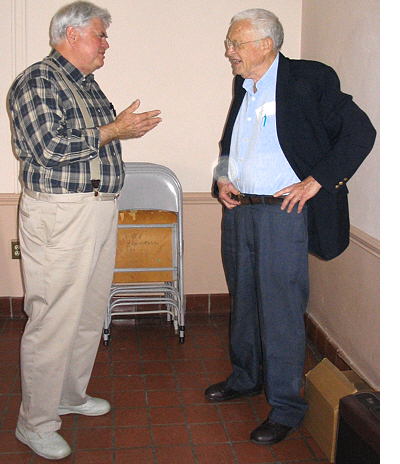 As a skilled repairer of fine antique clocks in the Boston area, many years ago Richard began to take special notice of examples of Simon Willard clocks brought into the shop for repairs. An early pioneer in analyzing clock movements, Richard finally accepted an offer of financial support to publish his observations from his friend, Walter Welch. Thus encouraged, the book, a product of 4 1/2 years of work in writing and organization on Richard's part, eventually became reality. As a skilled repairer of fine antique clocks in the Boston area, many years ago Richard began to take special notice of examples of Simon Willard clocks brought into the shop for repairs. An early pioneer in analyzing clock movements, Richard finally accepted an offer of financial support to publish his observations from his friend, Walter Welch. Thus encouraged, the book, a product of 4 1/2 years of work in writing and organization on Richard's part, eventually became reality.
Collectors' enthusiasm for Willard clocks has always flourished, and continues unabated until the present day. Richard began his presentation by explaining that although Simon Willard (1753-1848) produced many very beautiful and elegant products, Willard's strengths lie primarily in industrial design. Indeed, based on Richard's observations, Willard probably did not possess above average mechanical abilities.
Supporting his talk with a remarkable set of slides, Richard theorized that designs for Willard's bracket based wall and shelf clocks derived from English wheel barometers, and from several styles of European clocks likely brought to Willard's shop for repair. Willard probably relied largely on English movement "kits", which contained castings to be hand-filed by the user. Richard has observed some movements that likely left Willard's shop equipped with gears that did not even mesh properly.
Although Simon Willard held three patents: (1) for a mechanical roasting jack; (2) for his banjo clock; and (3) for a "portable" lantern clock, Richard explained that the language of each was vague enough to admit the use of imported movements. However, the patents seem to have served an important role in promoting Willard's unquestionably tasteful products. Indeed, particularly in the case of wall and shelf clocks, Willard strove to produce desirable products that could compete on the basis of lower prices.
Richard, who seemed to appreciate the audience's involvement as much as attendees appreciated hearing more about his work, graciously extended his talk by fielding a number of interesting questions. We extend our hearty thanks to him for a most thought-provoking and entertaining presentation.
[Photo: Chapter member Al Comen (left) is shown discussing Simon Willard clocks with Richard Husher (right) after Richard's presentation at the May 17 meeting.]
March 15, 2008 Meeting Highlights
by Mary Jane Dapkus
Chapter 148 members and friends met on Saturday morning, March 15. Despite a gray and inauspicious start to the day, the meeting's events rose far above the mediocre, a tribute to the chapter's outstanding membership.
The mart proved to be an exceptional place not only to acquire great items to add to home libraries, but also to learn about what others are reading. It is also an excellent place to search when trying to fill out one's collection of back issues of the Bulletin.
Coming up soon, the Chapter eagerly anticipates a series of two clock and watch repair suitcase workshops, in intoductory and advanced lathe techniques, respectively. The first workshop, entitled "Introduction to the WW [initials of maker's name] Lathe", will be held on Saturday, April 5. The second, "Advanced Techniques", will be given on May 3.
Each comprehensive lathe course is scheduled to extend over an entire day, and will include continental breakfast and lunch both days. The chapter is very pleased to introduce Matthew Minor, NAWCC Verified Master Clockmaker and Master Watchmaker, previously an instructor at NAWCC's School of Horology, who will instruct both sessions. These classes promise much benefit for both novice and seasoned repairer.
The Chapter also looks forward to welcoming a special guest, Richard W. Husher, recognized authority on Simon Willard clocks, who will speak on the subject at our next meeting. Together with Walter W. Welch, Richard is co-author of the remarkable book entitled A Study of Simon Willard's Clocks (Nahant, Massachusetts: 1980). For those who do not have a copy in their libraries, this book is the definitive source of information on Willard's clocks--elegant and elite objects in their own time that remain so today. (Stay tuned.)
* * *
Jan. 19, 2008 Meeting Highlights
by Mary Jane Dapkus
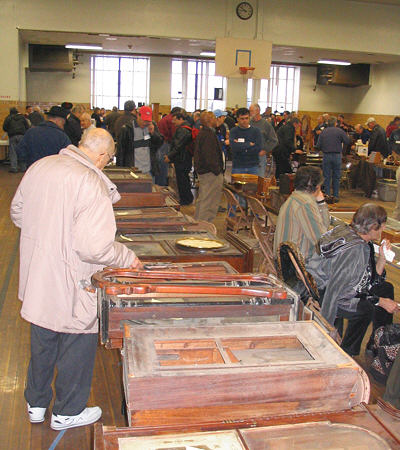 |
|
Both quantity and quality of mart offerings consistently achieve outstanding levels at Ch. 148's January mart. For example, many attendees remarked on a Howard #70 regulator with natural oak finish. Member and table holder Chester Hicks, who is also a clock repairer of the highest caliber, offered this fine and unusual object in "mint" original condition.
In addition to exciting objects, although our January meetings traditionally do not include speakers, informal educational exhibits and materials are often encountered among mart tables. Members located one example at the table of Bill Curley.
Bill provided photographs, measurements, scale drawings, and finished examples detailing several highly skilled clock repair and restoration projects based on computer-aided design (CAD) techniques. Bill utilizes the CAD drawngs as input for wire electrical discharge machining (known as wire EDM)--a technique involving costly equipment beyond the reach of most home workshops.
Since most clock parts are made from electrically conductive materials, Bill is able to employ wire EDM to save considerable time in executing complex parts replication tasks. He explained the use of this specialized equipment in producing hands, fly cutters to be fit into a horizontal miller to produce gears, fixtures used to "cross out" wheels, and specialized punches needed for each job. The technology, however, does not eliminate hand filing as a finishing step.
Bill has produced a tall clock calendar wheel flag, notched to accomodate a snail; and a brass crutch for a European tall clock, to name but a few of his accomplishments. Perhaps his most challenging project thus far, however, involved replacing a crown wheel escapement.: This project, Bill explained, was particularly interesting because the piece not only involved producing a complex three-dimensional fixture, but the part itself had to be cut from the inside. Notwithstanding these challenges, the results were quite remarkable and impressive.
The chapter plans to host several suitcase workshops during the upcoming year. Anticipated topics include the use of the graver and the jeweler's lathe. Stay tuned.
-- Mary Jane
|
| Chapter 148's first meeting of the New Year convened on Saturday January 19, 2008. Tableholders, members and guests filled the historic Edmond Town hall gymnasium. |
|
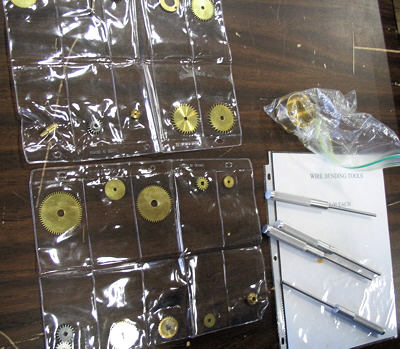 |
|
| Examples of member Bill Curley's craftsmanship, using CAD and wire EDM technologies. |
|
* * *
Meetings In 2007
Meetings In 2006
Meetings In 2005
Meetings In 2004
Meetings In 2003
Meetings In 2002
Meetings In 2001
Meetings In 2000
Meetings In 1999
Meetings In Years 1996 - 1998
|



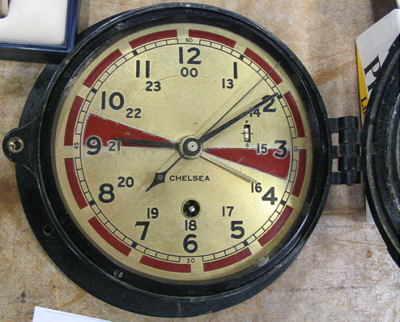
 July's guest speaker was Chris Bailey, noted author and long-time horologist-in-residence at the American Clock & Watch Museum, Bristol, CT. The subject of Chris's talk was American weight driven banjo clocks.
July's guest speaker was Chris Bailey, noted author and long-time horologist-in-residence at the American Clock & Watch Museum, Bristol, CT. The subject of Chris's talk was American weight driven banjo clocks. As a skilled repairer of fine antique clocks in the Boston area, many years ago Richard began to take special notice of examples of Simon Willard clocks brought into the shop for repairs. An early pioneer in analyzing clock movements, Richard finally accepted an offer of financial support to publish his observations from his friend, Walter Welch. Thus encouraged, the book, a product of 4 1/2 years of work in writing and organization on Richard's part, eventually became reality.
As a skilled repairer of fine antique clocks in the Boston area, many years ago Richard began to take special notice of examples of Simon Willard clocks brought into the shop for repairs. An early pioneer in analyzing clock movements, Richard finally accepted an offer of financial support to publish his observations from his friend, Walter Welch. Thus encouraged, the book, a product of 4 1/2 years of work in writing and organization on Richard's part, eventually became reality.